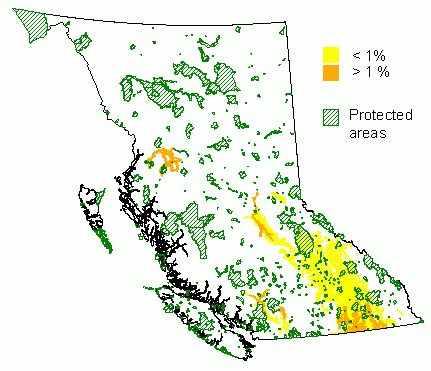 Hazelnut
Hazelnut
Corylus cornuta Marsh.
Introduction
Hazelnut is a deciduous shrub with multiple, spreading stems up to 4 or 6 m in height. Sometimes it is shaped as a tree with a single dominant stem. It occurs at low elevations (0-800m). The nuts are edible, sweet, and provide food for humans and wildlife. They are a staple food for birds and squirrels. Hazel helps to stabilize steep slopes (Zimmerman 1991). Corylus cornuta possesses valuable resistance to eastern filbert blight (Anisogramma anomala), a disease on commercial C. avellana plantations in the United States (Coyne et al. 1998). As such, it is of interest for C. avellana breeding. However, it also has a future for horticultural purposes in its own right (St. Pierre 1992). The first peoples ate the nuts whenever they were available (Turner 1995). The straight sucker shoots were made into arrows (Turner 1979).
Little (1977) provides a map for the distribution of hazelnut. There are two varieties of hazelnut, and both of them occur in British Columbia (Brayshaw 1996): var. cornuta (beaked hazelnut) ranges from the interior of British Columbia eastward to the Atlantic coast; and var. californica (California hazel) occurs in the central and southern portions of the Pacific region, with an extension into the central Cordilleran region. Its range stretches from British Columbia to California. In British Columbia var. californica occurs on the lower mainland and on Vancouver Island with a disjunct population, possibly of anthropogenic origin, near Hazelton in northwestern British Columbia (Haeussler and Coates 1986).
Distribution and Protected Areas – from Hamann et.al. 2005

Conservation Status Summary – from Chourmouzis et.al. 2009
No in situ conservation concerns were identified for this species.
Reproduction
California hazel produces large seed crops at irregular intervals, every two to five years. Late frosts can kill flowers, and dry weather can affect fertilization. Seeds are spread by small mammals and birds. They have poor viability in storage and must remain moist. Seed survival is low due to animal predation. Only a small number of nuts produce seedlings, yet in good seed years it is sufficient for the species to invade new sites. Hazel can re-sprout from the root crown top and can regenerate by layering (Brinkman 1974; Haeussler and Coates 1986).
Genetic structure
Intermediate forms of var. cornuta and var. californica may occur in the Fraser Canyon and Columbia Forest Region of British Columbia (Brayshaw 1976).
Resource management and seed transfer
No information available.
REFERENCES
Hamann, A., Smets, P., Aitken, S. N. and Yanchuk, A. D. 2005. An ecogeographic framework for in situ conservation of forest trees in British Columbia. Can. J. For. Res. 35:2553-2561. View online resources for this report.
C. Chourmouzis, A.D. Yanchuk, A. Hamann, P. Smets, and S.N. Aitken. 2009. Forest Tree Genetic Conservation Status Report 1: In situ conservation status of all indigenous BC species. Centre for Forest Conservation Genetics, Forest Genetics Council of BC, and BC Ministry of Forests and Range, Forest Science Program, Victoria, BC Technical Report 053. www.for.gov.bc.ca/hfd/pubs/Docs/Tr/Tr053.htm
Brayshaw, T. C. 1976. Catkin bearing plants of British Columbia. Occas. Pap. No. 18. The British Columbia Provincial Museum, Victoria, BC.176 p.
Brayshaw, T. C. 1996. Trees and shrubs of British Columbia. Royal British Columbia Museum handbook. UBC Press, Vancouver. 374 p.
Brinkman, K. A. 1974. Corylus L. hazel, filbert. p. 343-345 in: C. S. Schopmeyer (Ed.), Seeds of woody plants in the United States. Agric. Handb. 450. U.S. Department of Agriculture, Forest Service, Washington, DC.
Coyne, C. J., Mehlenbacher, S. A. and Smith, D. C. 1998. Sources of resistance to eastern filbert blight in hazelnut. Journal of the American Society for Horticultural Science 123:253-257.
Haeussler, S. and Coates, D. 1986. Autecological characteristics of selected species that compete with conifers in British Columbia : a literature review. Land management report no.33. Province of British Columbia Ministry of Forests, Victoria. 180 p.
Little, E. L., Jr. 1977. Atlas of United States trees, volume 4, minor eastern hardwoods. U.S. Department of Agriculture Miscellaneous Publication 1342. 17 p., 230 maps.
St. Pierre, R. G. 1992. The development of native fruit species as horticultural crops in Saskatchewan. Hortscience 27:866-947.
Turner, N. J. 1979. Plants in British Columbia Indian technology. B.C. Provincial Museum Handbook no. 38. BC Provincial Museum, Victoria, B.C. 304 p.
Turner, N. J. 1995. Food plants of coastal First Peoples. Handbook – Royal British Columbia Museum. UBC Press, Vancouver. 164 p.
Zimmerman, M. L. 1991. Corylus cornuta var. californica. U.S. Department of Agriculture, Forest Service, Rocky Mountain Research Station, Fire Sciences Laboratory (2002, January). Fire Effects Information System, [Online]. Available: http://www.fs.fed.us/database/feis/ [February 2002].
